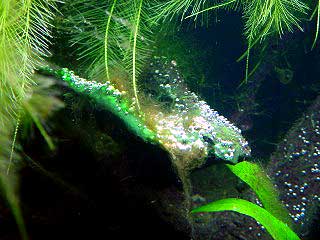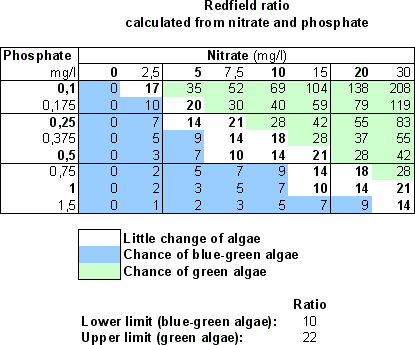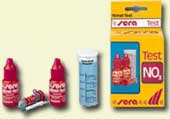How it all started
At the newsgroup of the Dutch Aquarium Society (NBAT) we witnessed the battle of Adriaan Briene against the blue-green algae in his aquarium. Striking was that he tackled this problem in a refreshing way: first he started reading like a mad man and after doing so he started. And - holy smoke - it worked! I must honestly say that his way of acting interfered with everything that I knew till then about maintaining an aquarium. When I read or heard "blue-green algae" I always thought "water pollution so a change of water is needed" But Adriaan was thinking: "I must add nitrogen, so I remove the blue-green algae out of my tank and put that in my filter". Unlogical? Go on reading.

He read something about the so called Redfield ratio. That is the ratio between the quantity of nitrogen and phosphorus in the water. Several researchers have used the Redfield ratio to see what the influence is of different values on the occurrence of various types of algae. An article of Bulgakov et al. has been translated by Agnes Zaalinto Dutch; my thanks to her. It seems that the change of getting green algae is big, if comparatively much nitrogen and little phosphorus is in the water. In reverse, little nitrogen c.q. a lot of phosphorus leads to a big change that you will start growing blue-green algae. The optimum seems to be at the proportion nitrogen:phosphorus = 16:1. Which means a Redfield ratio of 16.
Redfield and the aquarium
All right, what should you do with it, with nitrogen and phosphorus? Elements that probably don't mean a thing to you. However nowadays there are measuring sets to obtain in shops, like ammonium (NH4+), nitrite (NO2-), nitrate (NO3-) and phosphate (PO43+). Besides, it is easy to convert nitrate to nitrogen and phosphate to phosphorus. For those who are interested: click here (still in Dutch).

For everybody else I have recapitulated it in a schedule. It works like this: search for the measured nitrate percentage (on top) and the - phosphate percentage (left) and at the crossing in the schedule you will find the Redfield ratio. A point in the blue area means chance of having blue-green algae; a point in the green part ... exactly, green algae. For the happy few amongst us, there has been reserved a spot somewhere in the middle: paradise for an aquarist.
Application
As mentioned before, Adriaan Briene removed blue-green algae from his aquarium and put them it in his filter. What happened then? Blue-green algae can obtain free nitrogen gass from the air. By putting them in the filter under his tank (in darkness) they died and so the nitrogen was released again. So the Redfield ratio increased and was removed from the blue part of the schedule. The blue-green algae died and his tank was a lot cleaner.
When I read this story I tried his method in my aquarium. Of course I already had changed water on a regular base, hanged tea bags in my aquarium and whatever you can think of. At one time moment I bought a measuring set for nitrate and phosphate. What seemed to be the case? A little bit of phosphate (0,25 mg/l) and no nitrate at all (0 mg/l). Advised by all-time national vice-champion (2e place national home examination NBAT in 2001 and 2002, and before that with a high score also), who had started fertilizing earlier with potassium, it seemed logical to me to combine two important fertilizers, potassium and nitrate, and I added potassium nitrate. Potassium nitrate (KNO3) is for sale at the pharmacist, a.o. I could have used ammonium- or ureum nitrate, but however this might be even better for the plants, those two materials are poisonous for fish and lower-grade animals. My tank also changed within 1-2 weeks from a tank full of flocks of algae via a tank with an abundance of long hairy algae to a tank which is nearly free of algae!
After that I asked Willem Zaal about the values of his tank. His answer was: 0,2 mg/l phosphate and 5 mg/l nitrate. This has been stable for years. Quick calculating shows a Redfield ratio of 17! Now I knew how champions do it! What people like Willem and Ruud Setteur (another champion) had done by their experience of many years, was regulating at the Redfield ratio, of course besides making breathtaking compositions with their plants, using technical equipment which works smoothly etc.
The Redfield ratio calculator
For an aquarium free of algae, the nitrogen - phosphorus ratio has to be
around 16 : 1. You can only measure nitrogen in the form of nitrate (and ammonium
and nitrate, but those values are low) and phosphorus only in the form of phosphate.
Besides that you must also calculate how much potassium nitrate you should add
of. Troublesome and quite a time consuming job. That is why I made the calculator
below. You fill in the nitrate- and phosphate percentage from the water in your
aquarium, which elements you use to repair the balance and what is the net content
(so only the water) of your aquarium. Then you click the button : "Click
here for advice" and you can read whether you have to change water or have
to add elements.
We are talking again and again about the Redfield ratio (nitrogen/phosphorus ratio), but it would be easier and more logical for aquarist to talk about the nitrate/phosphate ratio. For that is what you measure. Since Buddendorf ratio doesn't sound to easy and many of my friends call my "Buddy", I have introduced, totally immodest, the term Buddy ratio (see green info column). Because you too want to know immediately after measuring nitrate and phosphate how your tank is doing, don't you J?
Explanation Redfield ratio calculator
The left half must be filled in by you, the right half shows what you could do to repair the balance in your tank.
Choice: i Measured
The best way to determine nitrate- and phosphate concentration is with a good measuring set (preferably Sera, however I explicitly don't want to advertise any company). > calculator
Choice: i Stock solution
It often is hard and unhandy to weigh a small quantity of powder every week. It is easier to weigh (have weighed) somewhat more once and dissolve that quantity in a bottle. We call that strongly concentrated solution a stock solution. You have to fill in how many milligrammes (mg) you dissolved in how much water (ml). The calculator calculates how much of that stock solution you must add at the end, after possible water change. Tip: you can buy syringes at the chemist's to add your stock solutions to your aquarium very accurately. > calculator
Choice: i Algae
For special aquaria, in which a little bit of green algae is appreciated (like a tank with cichlids or shrimps and lobsters), there is a possibility to indicate that now. Then the aquarium is managed at a Redfield ratio that is somewhat higher (RR ~ 20) The calculator will advise you to add more potassium nitrate or less potassium phosphate, depending on the situation in your tank. > calculator
Choice: i Net volume aquarium
For possible adding of nitrate and/or phosphate the calculator must know how large your tank is, because otherwise you add too much or too little. The net volume of your tank really is only the water in your tank. So without the empty space above the water till the top of the tank, without gravel, stones, drift wood etc. Via the link you can calculate the net volume of your tank. > calculator
Not the key factor
Of course an aquarist has to fill up a few conditions. Water changes will be needed (although maybe not every two weeks), a healthy quantity of plants also remain necessary, CO2 will keep on supporting a far better plant growth, light and warmth still are a must. You have to consider the Redfield ratio as an addition to what we already know about keeping an aquarium. As a very useful weapon against algae. Because, say it yourself, keeping an aquarium is only going to be fun again without (too much) algae!



